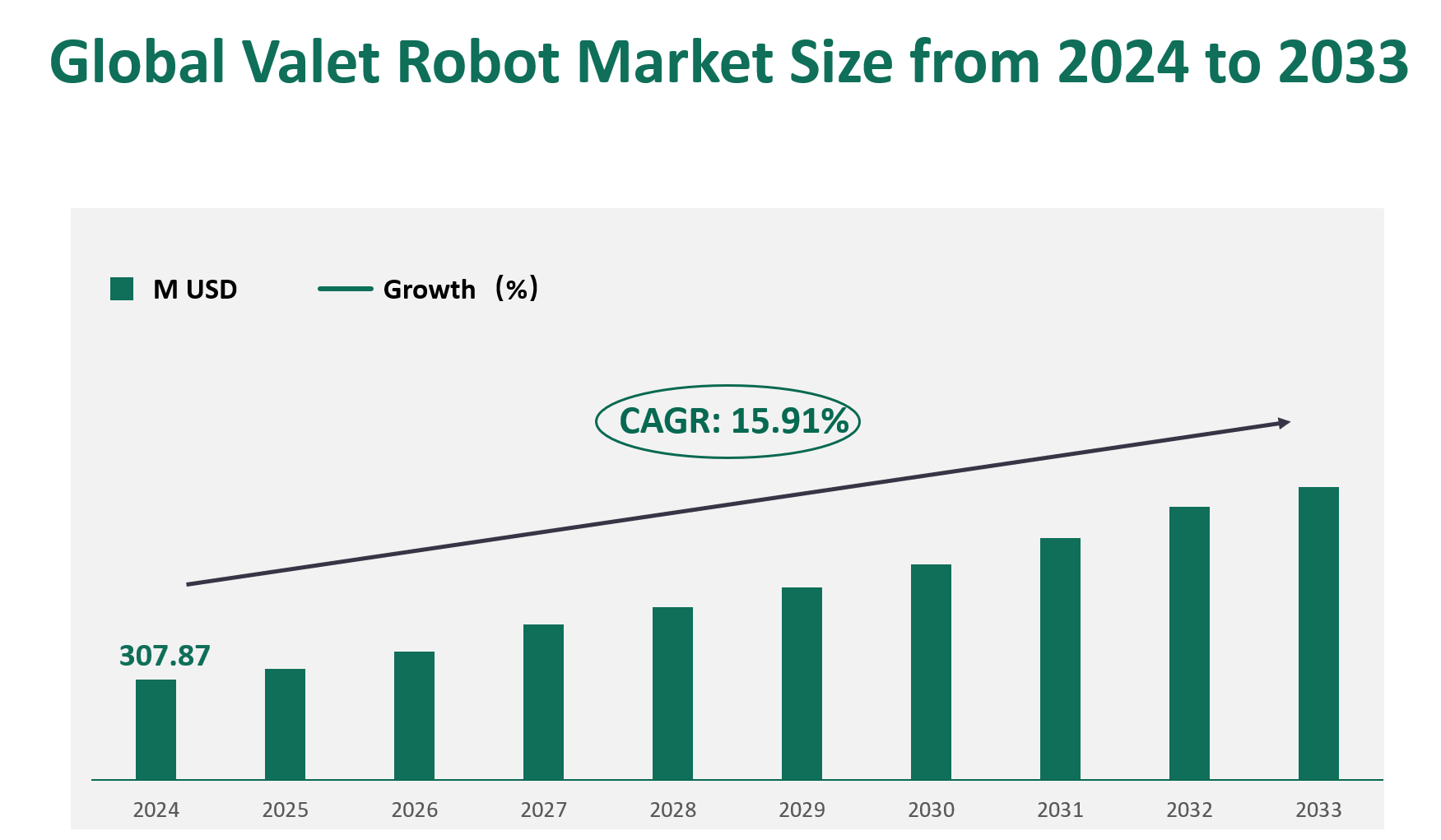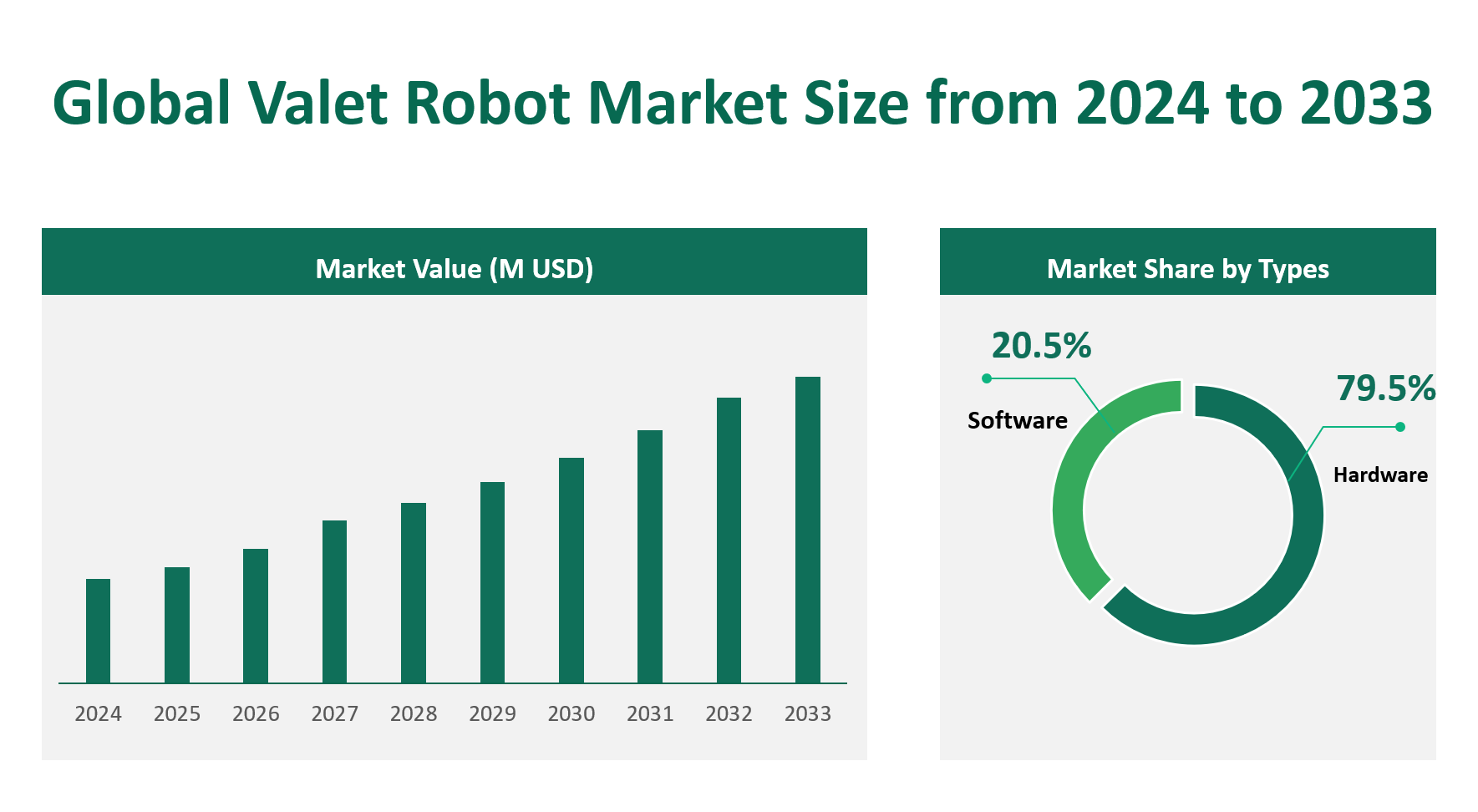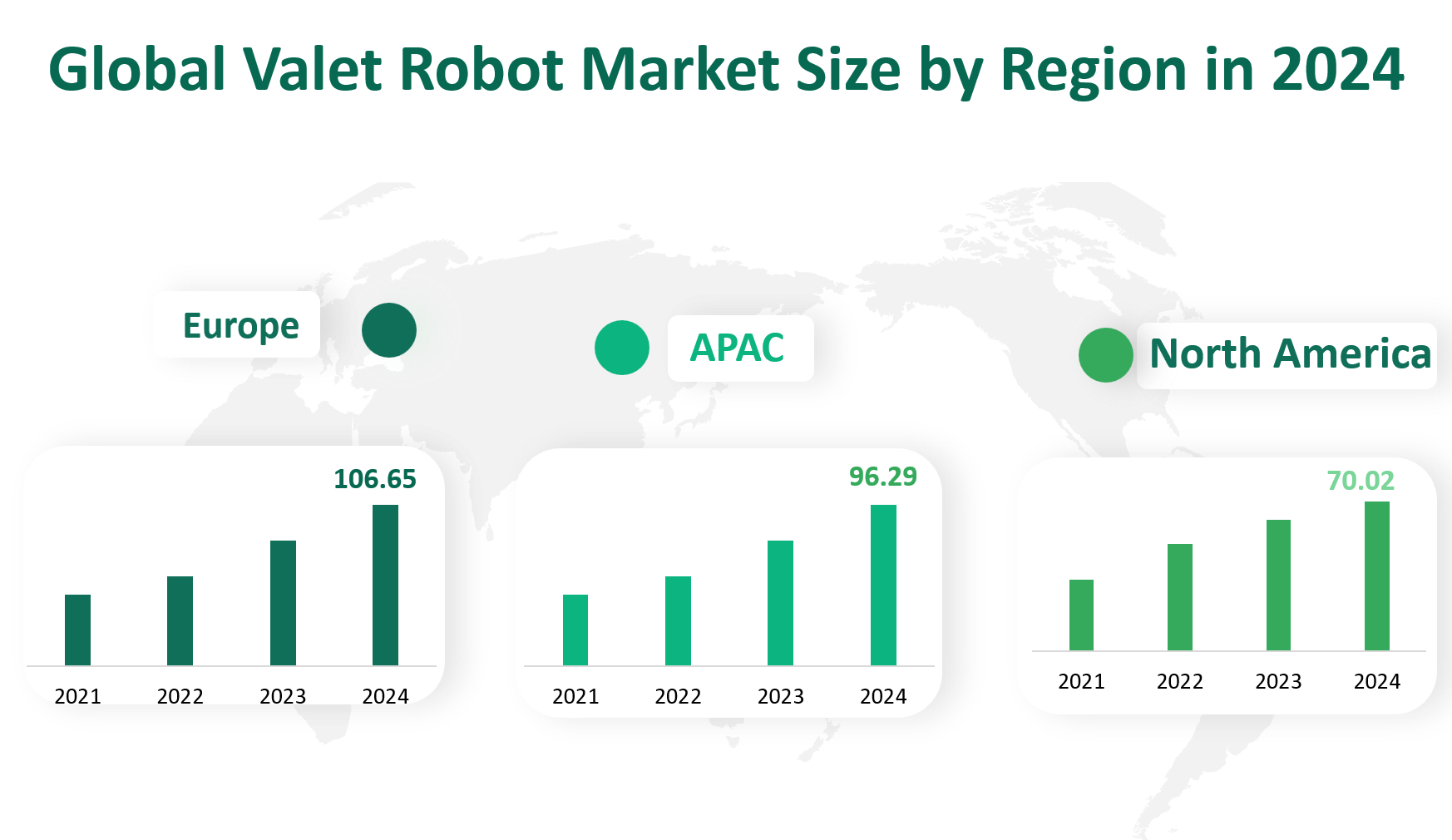1. Global Valet Robot Market Revenue and Future Growth
In 2024, the global Valet Robot market is projected to reach a revenue of $307.87 million, with a Compound Annual Growth Rate (CAGR) of 15.91% from 2024 to 2033.
Valet Robots represent a significant advancement in the field of automated parking solutions. These robots are designed to alleviate the common issues of traffic congestion and lack of parking infrastructure by efficiently managing vehicle parking. They operate using a combination of advanced sensors, embedded software, actuators, and require no human operator.
The system works by having customers park their cars in designated hangars where the vehicles are scanned to confirm their make and model. The Valet Robot then drives in, slides a platform under the vehicle, lifts it, and transports it to a parking spot. This technology not only maximizes space utilization but also enhances security and convenience for users.
Figure Global Valet Robot Market Size (M USD) and CAGR (2024-2033)

2. Driving Factors and Limiting Factors of Valet Robot Market
The growth of the Valet Robot market is driven by several key factors. Firstly, the increasing number of vehicles on the road has led to a higher demand for efficient parking solutions. Valet Robots offer a space-saving alternative, capable of fitting 50% more cars into the same area compared to traditional parking methods. This is particularly beneficial in urban areas where space is at a premium. Secondly, technological advancements in robotics, artificial intelligence, and sensor technology have made Valet Robots more reliable and efficient. They can now handle a wider range of vehicle types and sizes, and their precision driving capabilities have improved significantly.
However, there are also limiting factors that could hinder the market’s growth. The high initial investment required for the installation of Valet Robot systems can be a barrier for some businesses, especially small and medium-sized enterprises. Additionally, the need for regular maintenance and updates to the software and hardware can add to the overall cost. Furthermore, the market is still relatively new, and there may be a lack of awareness among potential customers about the benefits of using Valet Robots.
3. Technology Innovation and Corporate Mergers and Acquisitions in Valet Robot Market
The Valet Robot market is experiencing significant technological innovations. Companies are focusing on developing more advanced sensor technologies to improve the accuracy and safety of the robots. For example, the integration of laser navigation and mapping software allows the robots to precisely deliver vehicles to their parking spots. There is also a trend towards the development of more user-friendly interfaces for customers to interact with the system, such as mobile apps that allow users to reserve parking spots and track the location of their vehicles.
In terms of corporate mergers and acquisitions, the market is seeing consolidation as larger companies seek to expand their product offerings and market share. For instance, some of the major players like Lödige Industries, yeefung, and HIKROBOT are actively looking to acquire smaller firms with complementary technologies or market segments. These strategic moves are aimed at strengthening their positions in the market and enhancing their capabilities to offer integrated solutions to customers. Additionally, there is an increasing collaboration between technology companies and traditional parking solution providers to combine their expertise and create more innovative products.
4. Global Valet Robot Market by Types
Valet robots can be categorized into two primary types: software and hardware.
The software component of valet robots is essential for the system’s operation. It includes laser navigation and mapping software, programmable logic controllers, and management software. These elements work together to ensure that the robots can accurately and efficiently park vehicles. In 2024, the revenue generated by the software segment is projected to be $63.11 million.
The hardware segment of the valet robot market comprises the physical components of the system, such as sensors, actuators, loading areas, and other auxiliary facilities. These elements are vital for the actual movement and parking of vehicles. In 2024, the hardware segment is expected to generate a revenue of $244.76 million, making it the largest segment in terms of market share
Figure Global Valet Robot Market Share by Type in 2024

5. Global Valet Robot Market by Applications
Airports are one of the primary applications for valet robots. The need for efficient parking solutions at airports is critical due to the high volume of vehicles and the limited space available for long-term parking. In 2024, the revenue generated by the airport application segment is projected to be $120.99 million. This segment has the largest market share among all applications.
Shopping malls are another significant application for valet robots. With the rise of urbanization and the increasing number of shopping centers, the demand for efficient parking solutions has grown. In 2024, the revenue generated by the shopping mall application segment is projected to be $103.75 million.
Private parking lots, including those for residential and commercial buildings, also benefit from valet robot technology. These robots can autonomously park vehicles in designated spaces, increasing the parking capacity and security of the lots. In 2024, the revenue generated by the private parking lot application segment is projected to be $61.50 million.
Table Global Valet Robot Market Size by Application in 2024
Application | Market Size (M USD) 2024 |
Airports | 120.99 |
Shopping Malls | 103.75 |
Private Parking Lots | 61.50 |
Others | 21.63 |
6. Global Valet Robot Market Size by Region
North America is a key market for valet robots, with a projected revenue of $70.02 million in 2024. This region has been at the forefront of adopting advanced parking technologies, driven by the high demand for efficient parking solutions in urban areas and the presence of several major technology hubs.
Europe is the largest regional market for valet robots, with a projected revenue of $106.65 million in 2024. The region’s strong industrial base, coupled with a high emphasis on innovation and sustainability, has led to a rapid adoption of valet robot technologies. The growth rate in Europe is also robust, with a projected increase of 16.85% from 2023 to 2024.
The Asia-Pacific region is the fastest-growing market for valet robots, with a projected revenue of $96.29 million in 2024. This rapid growth can be attributed to the region’s rapid urbanization, increasing vehicle ownership, and the need for efficient parking solutions.
South America is also showing promising growth in the valet robot market, with a projected revenue of $14.10 million in 2024. The region’s growth rate is 15.63% from 2023 to 2024, making it one of the faster-growing regions. The region’s growth is driven by the need to address parking shortages in urban areas and the increasing awareness of the benefits of automated parking solutions.
The Middle East and Africa region is projected to have a revenue of $20.80 million in 2024, with a growth rate of 11.88% from 2023 to 2024. The region’s growth is driven by the increasing investment in infrastructure development, particularly in countries like Saudi Arabia and the UAE. The need for efficient parking solutions in large commercial and residential complexes, as well as in airports, is driving the adoption of valet robot technologies.
Figure Global Valet Robot Market Size by Region in 2024

7. Global Valet Robot Market Analysis by Major Players
7.1 Lödige Industries
Introduction and Business Overview: Lödige Industries, established in 1948 and headquartered in Germany, is a leading global supplier of logistics systems and machinery. The company is renowned for its commitment to quality, innovation, and partnership, providing reliable material handling solutions.
Products: Lödige Industries offers a range of automated parking systems that deliver significant space savings. Their solutions can be adapted to individual requirements and integrated into both new and existing buildings.
7.2 yeefung
Introduction and Business Overview: Founded in 1989, yeefung is a prominent manufacturer of home appliances and industrial automation equipment. The company expanded into the robotics and intelligent logistics sector with the establishment of Shenzhen YeeFung Robotics Co., LTD in 2014.
Products: yeefung’s product portfolio includes parking AGV, logistics AGV, e-commerce sorting AGV, and patrol AGV. Their GETA parking AGV is particularly notable for its innovative AGV mechanical engineering and laser navigation capabilities.
7.3 HIKROBOT
Introduction and Business Overview: HIKROBOT, established in 2016 and headquartered in China, is a global manufacturer and supplier of mobile robots and machine vision products. The company is dedicated to advancing the intelligence of robots and leading the intelligent manufacturing process.
Products: HIKROBOT’s offerings include the MR-H9-3000CH-A1(H) lifting smart parking system, which features autonomous positioning and navigation, flexible motion control, intelligent power management, and multiple safety protections.
7.4 Stanley Robotics
Introduction and Business Overview: Founded in 2015 and headquartered in France, Stanley Robotics is a pioneering company in the field of robotic valet parking services. The company’s solution aims to revolutionize parking experiences by offering a high-density car storage solution without modifying existing infrastructure.
Products: Stanley Robotics provides an efficient and cost-effective solution for finished vehicle logistics operators. Their autonomous platform and intelligent management system ensure zero-emission car storage and optimized space utilization.
7.5 PARKPLUS
Introduction and Business Overview: PARKPLUS, established in 1969 and headquartered in the USA, is a leading provider of high-density parking systems. The company designs, manufactures, installs, and maintains patented solutions for automated parking systems and multi-level car stackers.
Products: PARKPLUS offers AGV automated parking solutions that feature free-roaming, self-charging, omni-directional robots. These systems provide maximum parking efficiency, flexible floorplan configurations, and intelligent traffic management.

